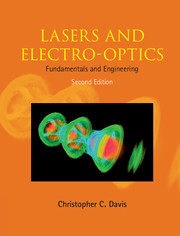Book contents
- Frontmatter
- Contents
- Preface to the Second Edition
- 1 Electromagnetic waves, light, and lasers
- 2 Optical frequency amplifiers
- 3 An introduction to two practical laser systems
- 4 Optical resonators containing amplifying media
- 5 Laser radiation
- 6 Control of laser oscillators
- 7 Optically pumped solid-state lasers
- 8 Gas lasers
- 9 Molecular gas lasers I
- 10 Molecular gas lasers II
- 11 Tunable lasers
- 12 Semiconductor lasers
- 13 Passive optical systems
- 14 Periodic optical systems, resonators, and inhomogeneous media
- 15 The optics of Gaussian beams
- 16 Optical fibers and waveguides
- 17 The optics of anisotropic media
- 18 The electro-optic and acousto-optic effects and modulation of light beams
- 19 Introduction to nonlinear processes
- 20 Wave propagation in nonlinear media
- 21 Detection of optical radiation
- 22 Coherence theory
- 23 Laser applications
- Appendix 1 Optical terminology
- Appendix 2 The ´-function
- Appendix 3 Black-body radiation formulas
- Appendix 4 RLC circuits
- Appendix 5 Storage and transport of energy by electromagnetic fields
- Appendix 6 The reflection and refraction of a plane electromagnetic wave at a boundary between two isotropicmedia of different refractive indices
- Appendix 7 The vector differential equation for light rays
- Appendix 8 Symmetry properties of crystals and the 32 crystal classes
- Appendix 9 Tensors
- Appendix 10 Bessel-function relations
- Appendix 11 Green's functions
- Appendix 12 Recommended values of some physical constants
- Index
- References
21 - Detection of optical radiation
Published online by Cambridge University Press: 05 June 2014
- Frontmatter
- Contents
- Preface to the Second Edition
- 1 Electromagnetic waves, light, and lasers
- 2 Optical frequency amplifiers
- 3 An introduction to two practical laser systems
- 4 Optical resonators containing amplifying media
- 5 Laser radiation
- 6 Control of laser oscillators
- 7 Optically pumped solid-state lasers
- 8 Gas lasers
- 9 Molecular gas lasers I
- 10 Molecular gas lasers II
- 11 Tunable lasers
- 12 Semiconductor lasers
- 13 Passive optical systems
- 14 Periodic optical systems, resonators, and inhomogeneous media
- 15 The optics of Gaussian beams
- 16 Optical fibers and waveguides
- 17 The optics of anisotropic media
- 18 The electro-optic and acousto-optic effects and modulation of light beams
- 19 Introduction to nonlinear processes
- 20 Wave propagation in nonlinear media
- 21 Detection of optical radiation
- 22 Coherence theory
- 23 Laser applications
- Appendix 1 Optical terminology
- Appendix 2 The ´-function
- Appendix 3 Black-body radiation formulas
- Appendix 4 RLC circuits
- Appendix 5 Storage and transport of energy by electromagnetic fields
- Appendix 6 The reflection and refraction of a plane electromagnetic wave at a boundary between two isotropicmedia of different refractive indices
- Appendix 7 The vector differential equation for light rays
- Appendix 8 Symmetry properties of crystals and the 32 crystal classes
- Appendix 9 Tensors
- Appendix 10 Bessel-function relations
- Appendix 11 Green's functions
- Appendix 12 Recommended values of some physical constants
- Index
- References
Summary
Introduction
In this chapter we will review some of the fundamentals of the optical detection process. This will include a discussion of the randomly fluctuating signals, known as noise, that appear at the output of any detector. We will then examine some of the practical characteristics of various types of optical detector. The chapter will conclude with a discussion of the limiting detection sensitivities of important detectors used in various ways.
Photon detectors operate by absorbing the photons coming from a source and using the absorbed energy to produce a change in the electrical characteristics of their active element(s). This can occur in many ways. In a photomultiplier or vacuum photodiode the incoming photons are absorbed in a photoemissive surface, and free electrons are produced by the photoelectric effect. These electrons can be accelerated and detected as an electric current. In a semiconductor photodiode or photovoltaic detector, absorption of a photon at a p–n or p–i–n junction creates an electron–hole pair. The electron and hole separate because of the energy barrier at the junction – each carrier moves to the region where it can reduce its potential energy, as shown in Fig. 21.1.
Thermal radiation detectors use the heating effect produced by absorbed photons to change some characteristic of the detector element. In a bolometer, the heating of carriers changes their mobility and consequently the resistivity of the detector element. In a thermopile, the heating effect is used to generate a voltage through the thermoelectric (Seebeck) effect.
- Type
- Chapter
- Information
- Lasers and Electro-opticsFundamentals and Engineering, pp. 684 - 735Publisher: Cambridge University PressPrint publication year: 2014



